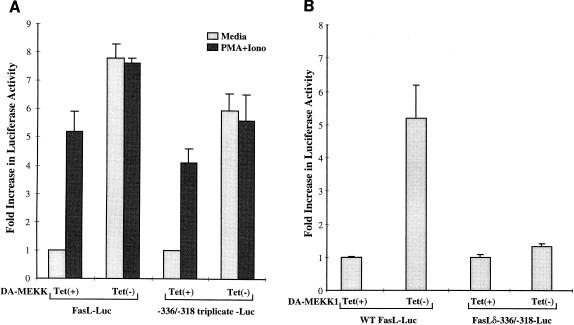FIG. 6.
The response element between positions −336 and −318 is critical for MEKK1-mediated FasL promoter activity. (A) Luciferase assay showing the effect of the DA-MEKK1 on the transcriptional activation of the MEKK1-responsive element. DA-MEKK1 cells were transiently transfected with 30 μg of luciferase constructs representing the 486-bp FasL promoter or the triplicated −336-to-−318 site. The cells were grown in the presence or absence of 0.1 μg of tetracycline/ml for 24 h. Cells were either left unstimulated or treated with 100 nM PMA plus 1 μg of ionomycin (Iono)/ml for 8 h. The cells were lysed and analyzed for luciferase activity as for Fig. 3. The fold increase in luciferase activity was calculated based on the value for tet+ cells. Transfection efficiency was monitored by cotransfection of a β-galactosidase-encoding plasmid (CMV-β-Gal). These data are representative of three experiments. (B) Luciferase assay showing the regulation of the FasL promoter by the MEKK1 response element. DA-MEKK1 cells were transiently transfected with 30 μg of the wild-type FasL-486 reporter or the FasLδ−336/−318 construct carrying a mutant MEKK1-responsive element. The cells were grown in the presence or absence of 0.1 μg of tetracycline/ml for 24 h, lysed, and analyzed for luciferase activity. The fold increase in luciferase activity was calculated based on the value for tet+ cells.

